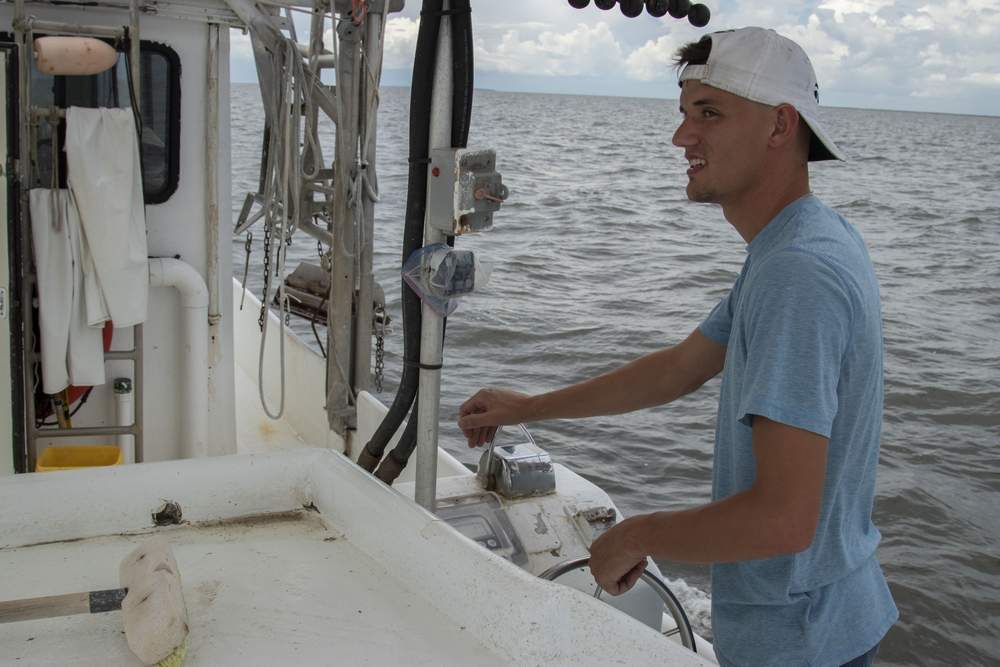Erin Jordan / The Gazette
2 December 2018
‘They need to say it’s against the law to pollute downstream’

CYPREMORT POINT, LA. — Tommy Olander Jr. took his first baby steps on the deck of a 42-by-16-foot Lafitte skiff shrimp trawler. His dad, Thomas Olander, named the boat Tommy Boy after his son, now 25.
“I’d rather be broke and shrimping than get out of it,” the younger Olander said, piloting his father’s boat in August around Vermilion Bay, an inlet of the Gulf of Mexico by Louisiana.
But Olander did leave the business, selling his own boat and moving to Florida to repair generators for AT&T. He made a trip home in August for the start of the fall shrimp season, when energetic shrimpers fish day and night until they’ve caught their haul or their ice has melted.
The Louisiana shrimp industry is facing major economic and environmental challenges including low prices for shrimp, natural disasters, laws to protect endangered turtles and a Delaware-size dead zone with too little oxygen for aquatic life.
“The main focus has been about prices,” said Acy Cooper, 58, president of the Louisiana Shrimp Association. “But there’s also (turtle excluder devices), the dead zone and freshwater diversion.”
Tough times
Anxiety showed on the faces of many of the more than 120 shrimpers who came to the association’s Aug. 8 meeting in Houma, a city of 34,000 surrounded on three sides by bayou fishing communities. A glut of farmed shrimp from Asia has caused shrimp prices to plummet to levels on par with the 1980s, while the cost of fuel, ice and docking fees go up.
“We want a minimum price on our product and a maximum price on our fuel,” said Dean Blanchard, one of the nation’s largest shrimp distributors, based in Grand Isle. He and others complained about government disaster aid given to farmers, but not to commercial anglers.
A shrimper cutting through the surf can’t tell by its appearance when he’s entered the dead zone, but “you can’t catch nothing in it,” Cooper said. “That’s how you know it’s the dead zone.”
Low oxygen was blamed for thousands of fish dying in Isle de Jean Charles in October 2016, HoumaToday.com reported. Hypoxia also slows shrimp growth, which leads to fewer large shrimp — the ones that fetch the highest prices, according to a Duke University study funded by the National Oceanic and Atmospheric Administration.
Shrimpers crowd into the same inland waters to avoid the hypoxic zone, increasing competition for a shrinking pool of shrimp, said Thomas Olander Sr. Other species like sharks, trying to keep out of the hypoxic zone, make shrimp trawling more difficult and dangerous, he said.
What is the dead zone?
The dead zone is caused by high levels of nitrate and phosphorus, mostly from farm fertilizer, washing down the Mississippi River into the Gulf. These nutrients stimulate algae growth. When algae die and decompose, it uses up oxygen in the water, which then can kill fish or other aquatic life.
Nancy Rabalais, a Louisiana State University Professor of Oceanography and Coastal Science, has been measuring this hypoxic zone since 1985. She won a 2012 McArthur “Genius” award for her work mapping these morphing masses of low-oxygen water. This year’s measurement of 2,720 square miles was smaller than expected.
Rabalais suspects high winds and waves piled the low-oxygen water mass into a thicker layer, rather than spreading it out over the Gulf.
But the 34-year trendline is increasing.
“The five-year average still is about three times larger than the goal,” Rabalais said.
Rabalais and her research partner and husband, Gene Turner, spend a lot of their time educating the public, agricultural groups and journalists about the dead zone and what causes it.
“We’ll never be able to make a difference in the amount of nutrients that come into the river if we don’t try to continually educate people about the issue and possible solutions,” Rabalais said.
Turner, who spent his college years in the Midwest, first wrestling for Monmouth College in Illinois and then going to graduate school at Drake University in Des Moines, said the Gulf is a poster child for widespread water quality issues caused by large-scale agriculture.
Hypoxic zones also have developed on Chesapeake Bay, Lake Erie, Green Bay and Narragansett Bay, among other U.S. water bodies, NOAA reported.
“We can’t keep this industrial farming approach where we exploit, but we don’t put back,” Turner said.
States slow to act
The Gulf Restoration Network in New Orleans is the only environmental agency in Louisiana focused on the health of the Gulf of Mexico, said Matt Rota, senior policy director. It deals with issues including oil spills, coastal erosion and sea level rise, which lets saltwater into wetlands and kills them.
But the dead zone is a major problem, especially because Rota doesn’t see public officials stepping up to control agricultural runoff — even in Louisiana.
This past summer, Louisiana officials sought to remove some Gulf Coast waters from the federal impaired waters list, which would have reduced protections, Rota said.
“If Louisiana is denying the dead zone is a problem in Gulf waters, why should anyone else care?” Rota asked. “They need to say it’s against the law to pollute downstream.”
The main obstacle is a “wait-and-see” attitude for a problem with documented cause and known solutions, advocates said.
Besides the overall goals of reducing nitrate and phosphorus by 45 percent, the Gulf Hypoxia Task Force has an interim goal of a 20 percent reduction by 2025.
“The clock is ticking on that 2025 target and it’s a challenge to keep folks focused,” said Doug Daigle, an LSU researcher, coordinator of the Louisiana Hypoxia Working Group and member of the Lower Mississippi River sub-basin committee. “We should be tracking and working on everything we can to reach that target.”
